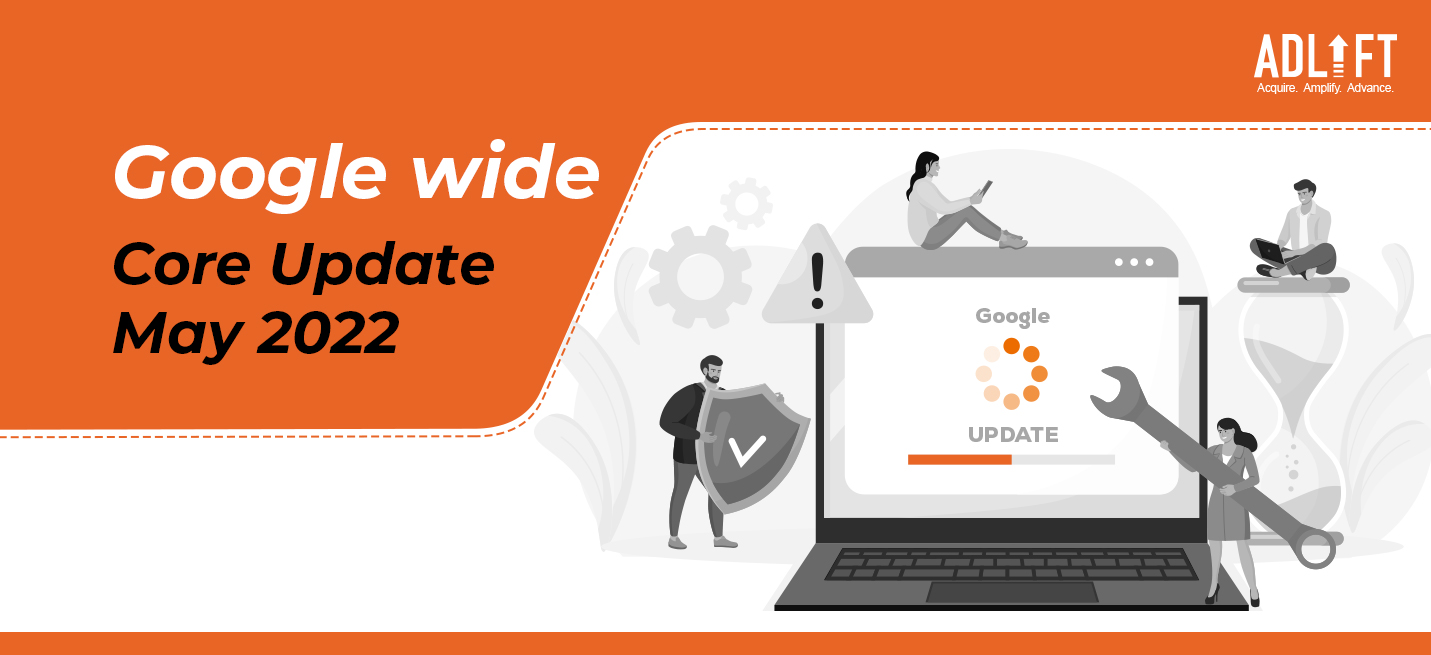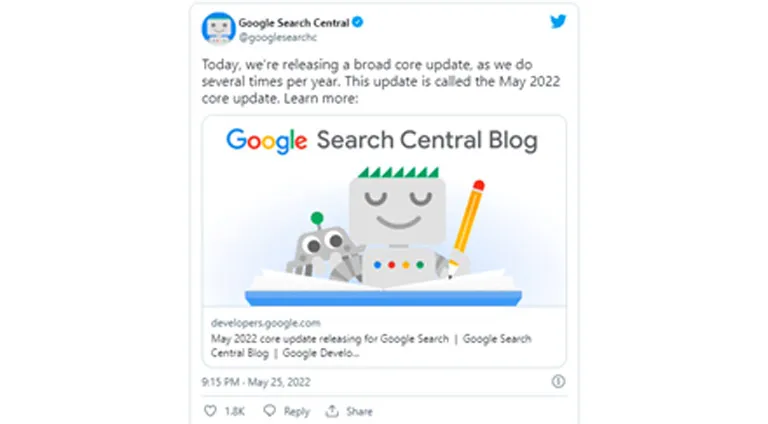Google Core Update: What is it?

On May 25, 2022, Google launched a “wide core upgrade” to its search-engine algorithm. Since Google releases significant upgrades gradually, it takes a few weeks before all their effects are felt. Since November 2021, this is a significant Google core update in almost six months. An algorithm update is looked at as a major event. It denotes that Google is improving the way its search engine reads webpages, which affects the rankings, traffic, and, consequently, the income of your business. It is challenging to evaluate, let alone plan for, a comprehensive core update.
Due to the broad breadth of broad core changes, Google doesn’t define what the upgrade is or how it will impact your website stats. However, a core update is a big adjustment that Google makes to its ranking formula that significantly affects many indexed websites. On average, they happen every two to three months. By rearranging the order in which indexed web pages appear in search results, core updates aim to increase the relevance and quality of Google’s search results. Every major update modifies the algorithm used by Google to rank websites. After a core update, web pages that previously performed well for their target keywords may do poorly. In contrast, web pages that previously performed poorly for their target keywords may do well after the launch.
What Impact Does the Google Core Update Have on Your SEO?
In a way, nothing concrete can be claimed. Again, Google never offers any precise information about significant fundamental upgrades.
Google’s core upgrades significantly impact search engine optimization (SEO). The fundamental idea behind Google SEO is to modify your website and online presence to favor them in Google’s ranking algorithm. Google’s ranking system changes when it releases a core update. Following the release of a core update, all the time, effort, and money you invested in optimizing your website for Google may have been for nothing. For example, A ranking indication that your website targeted may no longer have any beneficial effects due to a core upgrade. Your website’s search ranks will decline once the ranking signal is removed from the equation.
Core changes may even incur penalties that severely damage the search engine rankings of your website. For instance, the Panda update automatically and algorithmically penalized websites with inadequate content. Before its implementation, webmasters could rank their websites highly on Google without creating much content. By penalizing pages with such thin content as these, the Panda update changed the rules of the game. In addition, some major revisions reorganize Google’s search engine results pages, which have an impact beyond merely search rankings (SERPs). To add, remove, and change alternative listings in the SERPs, Google employs core updates. Alternative listings include unpaid elements like Knowledge Graph panels, Featured Snippets, and People Also Ask (PAA) listings.
How Frequently Should You Check for Google Core Update?
A core update is a big adjustment that Google makes to its ranking formula that has a significant impact on a lot of the indexed websites. On average, they happen every two to three months. By rearranging the order in which indexed web pages appear in search results, core updates aim to increase the relevance and quality of Google’s search results. Every major update modifies the algorithm used by Google to rank websites.
However, you can prepare your website for core changes in several ways. The first step is to do your homework; when Google releases the update, study it, and find out who and what it will affect so you can take measures to minimize any potential harm. With this knowledge, you can modify your website appropriately to make it compatible with the impending update. It is important to focus more on the quality of the content on your website and less on off-site promotion because core upgrades are intended to improve the quality of search results. Additionally, ensure you’re not using any unnecessary SEO techniques, as they will almost surely cause a decline in your site’s rankings and result in a subsequent penalty.
There are several ways to check for core updates:
- Twitter handle@GoogleSearchLiaison
- Utilize cost-free algorithm tracking applications like RankRanger and AccuRanker.
Recovery After the Google Core Update
Here are a few tips mentioned that can help you recover after the core Google update:
1. Fix your on-page SEO:
By enhancing your on-page SEO, you may make your material easier for readers and Google to access.
- To achieve that, make sure each of your photos has a meta description.
- Make sure that the image file names accurately describe the photos.
- Don’t make titles too lengthy or too short by optimizing them.
- Resize your photographs so that readers can access them more quickly.
Make sure all of your articles have a solid URL structure. Use rich media to compete for rich snippets in Google results and to help the Google bot better comprehend the purpose of your page.
2. Make a few changes to your content:
Updating your articles with the most recent information is one of the simplest things to start with. Update the previous posts with new information to bring them back up to date. If recent statistics are available, for instance, include them. If attitudes have evolved, your piece should reflect that. Existing, new, and improved methods of doing things? Make sure your readers know that your material cankeepup with industry changes. The Caffeine update, which Google announced in 2011, was a new web indexing technique that allowed Google to crawl and store material more effectively, enhancing its indexing rate and delivering fresh results. You can boost traffic to your current pages by vying for new keywords and themes.
3. Check your internal links:
To promote similar articles, develop content hubs, and improve page rank, plan your internal linking strategy. Maximize your link-building efforts by using a consistent internal linking approach to ensure that the advantages of incoming external connections are distributed to all your pages. Pages that don’t have any internal links going to them are known as orphan pages. They are therefore challenging for readers and web crawlers to find. Because of this, the page won’t be indexed by search engines and won’t be ranked for your desired keywords. When linking internally, use illustrative anchor texts since the reader needs to know where the link will take them before they click it. Additionally, ensure all internal links point to materials that clarify or expand on relevant content.
4. Carry out a technical audit of your website:
A technical audit reveals issues with your website, such as broken links and 404 errors. Use SEO tools like Ahrefs and MOZ if a technical audit proves to be too technical for you to complete on your own. Both offer a free account where you can access some of the functionalities of the technical audit tools. But in order to undertake a thorough audit, we advise getting a paid account for one of these tools. Another choice is to commission a complete site audit from an SEO company. They will evaluate your site’s performance in light of Google’s specifications while considering its technological stability, on-page SEO, and off-page SEO. Then, depending on your chosen provider, you can get guidelines or recommendations for how to use the report.
5. Your backlink profile would require auditing:
Google core updates do not directly target bad link profiles. However, a weak backlink profile still impacts the ranking of your website in the SERPs. As a result, monitor your backlink profile and steer clear of low-quality backlinks. In addition, check to see if any spammy links are pointing to your website. To remove the links that can harm your rankings and the health of your website, create and submit a disavow file. To remove links leading to your website that you deem detrimental, you can submit a disavow file to search engines like Google. Using the disavowing links feature in Google Search Console, it’s simple to add a disavow file to your website. But keep in mind that removing backlinks isn’t usually the first thing to do.
According to Google’s recommendations, you should only utilize a disavow file on two occasions:
- Your website is linked to by a lot of low-quality, spammy, or purchased links.
- Google has penalized you with a manual action.
Google has become fairly adept at determining whether to disregard a certain collection of bogus links. For instance, if a rival is carrying out a negative SEO attack on your website, Google would probably decide to ignore these connections.
Conclusion
Sites may experience significant fluctuation in search visibility when the upgrades go live because Google analyzes numerous criteria over a lengthy period with major core updates. First, determine whether there havebeen a shift in purpose, an adjustment in relevancy, or general site quality issues by looking at the declining top queries and landing pages. After that, create an offensive strategy based on your findings.
AdLift can assist you in identifying the problem and swiftly fixing it. Contact us soon!
Further reading on Google Updates:
Google September 2022 Broad Core Update

